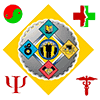
The SAFE-T-SENTINEL© Module
SAFE-T-SENTINEL
The existence of SAFE-T-SENTINEL’s is the ultimate goal of any proactive and mature safety aware organization. The SAFE-T-SENTINEL© is a specific intervention which may be implemented within an organization at a time when the more traditional behavioral observational programs have taken root. Once we have a significant population within the organization who have been trained in the competencies associated with SAFE-T-COACH© and SAFE-T-VIEW©; we are in a better position to strategically implement the SAFE-T-SENTINEL© intervention.
It is at the point when the majority of the workforce has acquired the skills of safe/unsafe observations, safety focused communications, the application of TSL within their day-to-day workplace interventions, that we can set the Sentinels free.
So what is a SAFE-T-SENTINEL© ?
A Sentinel is something that is forever “searching” or “on guard” for something. In the environment of a SAFE-T-SOS© Psycho-Behavioral integrated program, the SAFE-T-SENTINEL© is an identity free application of the principles of SAFE-T-VIEW© without the formalized structure. What this means is that an organization is releasing the intellectual capital it has created via the implementation of SAFE-T-VIEW©. As an employee is involved in a Sentinel interaction they mark it on their Sentinel Eye-Check. Sentinel Eye-Checks are submitted on an agreed basis and the data tracked using similar methodologies to SAFE-T-VIEW©.
The SAFE-T-SENTINEL© adds a level of exothermic power to the entire program, by making every employee (irrespective of employee level) a potential SAFE-T-SENTINEL©. When you have an effective SAFE-T-SENTINEL© program functioning within the business you are potentially recognizing over ninety-five percent (95%) of unsafe decisions/behaviors. Hazard recognition is arguably the most significant aspect of behavioural accident control. If you haven’t seen it (recognized), then you really can’t deal with it (control).
The SAFE-T-SENTINEL© process has it’s elemental foundation within the High Reliability Organizing (HRO) paradigm. The five hallmarks of HRO are:
- Sensitivity to operations
- Deference to expertise
- Commitment towards resilience
- Pre-occupation with failure
- Reluctance to simplify
 SAFE-T-SENTINEL© is the ultimate application of a safety culture which gives life to the goal of being permanently “sensitive to operations” and appropriately “pre-occupied with failure”. With enough SAFE-T-SENTINELS© “on patrol” inside the business a business is approaching ultimate system protection.
SAFE-T-SENTINEL© is the ultimate application of a safety culture which gives life to the goal of being permanently “sensitive to operations” and appropriately “pre-occupied with failure”. With enough SAFE-T-SENTINELS© “on patrol” inside the business a business is approaching ultimate system protection.
Every organizations’ ultimate goal should be the effective application of the SAFE-T-SENTINEL© program.
The SAFE-T-SENTINEL© program embeds an early warning system within all levels of your operations. More recently focus has moved away from disaster management within the science of “disaster management”. Focus has begun to be more directed towards improving a range of tools that can act in a co-ordinated way to be better able to predict/prepare for disaster. Workplace safety should be no different. The SAFE-T-SENTINEL© program does exactly that.
To read the International Labour Organzations psoition on the place of early warning systems within disaster management just Click Here. The Global Disaster Preparedness Centre also has a view on the value of early warning systems. To read their position just Click Here.
To read more about the SAFE-T-SOS Psycho-Behavioral Technologies just Click Here.
“The SAFE-T-SENTINEL program is the most powerfully exothermic safety pre-warning system you can have within your organization and it processes. Think of it as having a workforce whose individuals are each a pre-warning radar array”

Jerry, Los Angeles
![]()
“David Broadbent conducted a two (2) day safety program for our Company. The topic was all about safety culture with special reference to BBS. You could hear a penny drop when David said that he did not believe in BBS. We’d just flown this guy across from Australia. He then went on to explain why traditional BBS fails – though with some targeted modifications you can make it work. This was what he called Psycho-behavioral Safety (PBS). He sold everyone in the room and what he said really made sense. When David started talking about the goal of having Safety Sentinel’s throughout the workplace eyes began to really light-up. SAFE-T-SOS is a must have……”


